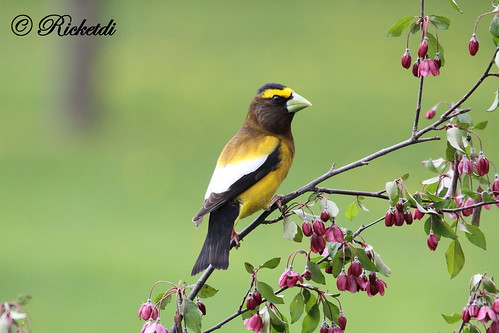Evening Grosbeak
(Coccothraustes vespertinus)
Conservation • Description • Habitat • Ecology • Distribution • Taxonomy
Description |
||
On the male, the head is brown with a black crown; a bold, bright yellow “eyebrow”; and a very large, light-colored, cone-shaped bill. The brown on the head fades into a golden-yellow breast and back. The underparts are yellow. The wings are black with a large, broad, white, wing patch. The tail is black and short. The female has a gray head and back, black and white wings, and no “eyebrow”. |
||
Size |
||
6¼″ to 8⅝″ in length 11¾″ to 14″ wingspan |
||
Voice |
||
Similar Species |
||
Habitat |
||
Coniferous and mixed woodlands, sometimes also deciduous woodlands; parks; and orchards |
||
Ecology |
||
Migration |
||
|
||
Nesting |
||
|
||
Food |
||
Mostly seeds, especially from pine and spruce cones, but also insects, especially spruce budworm (Choristoneura fumiferana). |
||
Distribution |
||||
Occurrence |
||||
Uncommon year-round resident in northern Minnesota; absent in the south |
||||
Maps |
||||
The Minnesota Ornithologists’ Union All Seasons Species Occurrence Map |
||||
Taxonomy |
|||
| Class | Aves (Birds) | ||
Order |
Passeriformes (Perching Birds) | ||
Family |
Fringillidae (finches, euphonias, and allies) | ||
Genus |
Coccothraustes (holarctic grosbeaks) | ||
The International Ornithologists’ Union (IOU) classifies the Evening Grosbeak as Hesperiphona vespertina, and the American Ornithologists’ Union (AOU) as Coccothraustes vespertinus. The AOU is the final authority for names of North American birds used in North America. Most, but not all, U.S. sources use Coccothraustes vespertinus. All other sources use Hesperiphona vespertina. |
|||
Subordinate Taxa |
|||
Western Evening Grosbeak (Coccothraustes vespertinus brooksi) Mexican Evening Grosbeak (Coccothraustes vespertinus montanus) Eastern Evening Grosbeak (Coccothraustes vespertinus vespertinus) |
|||
Synonyms |
|||
Hesperiphona vespertina |
|||
Visitor Photos |
|||||
Share your photo of this bird. |
|||||
| This button not working for you? Simply email us at info@MinnesotaSeasons.com. Attach one or more photos and, if you like, a caption. |
|||||
Bobbi Johnson |
|||||
Saw these two in my crab apple this morning. |
|||||
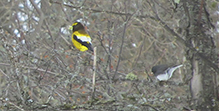 |
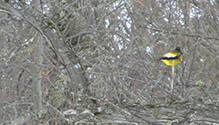 |
||||
Luciearl |
|||||
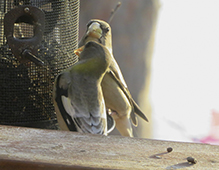 |
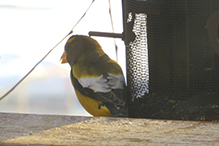 |
||||
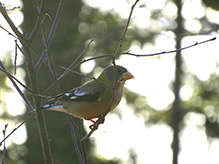 |
|||||
Laurie Wachholz |
|||||
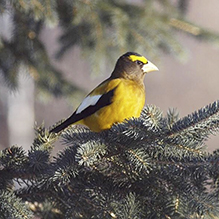 |
|||||
MinnesotaSeasons.com Photos |
|||||
|
|||||

Visitor Videos |
|||
Share your video of this bird. |
|||
| This button not working for you? Simply email us at info@MinnesotaSeasons.com. Attach a video, a YouTube link, or a cloud storage link. |
|||
Other Videos |
|||
| Evening Grosbeaks Glow In Sunlight – Feb. 2, 2018 Cornell Lab Bird Cams |
|||
About
Published on Feb 2, 2018 The late morning sunlight accentuates the bright yellow plumage of Evening Grosbeaks on the Ontario FeederWatch cam. Watch online with highlight clips and information about the birds at http://allaboutbirds.org/feederwatchcam Thanks to Perky-Pet for helping to make the Ontario FeederWatch Cam possible! The FeederWatch cam is located in a residential neighborhood in Manitouwadge, Ontario. This northern site is an excellent location to see winter finches like redpolls and grosbeaks as well as two species of Jays and even Ruffed Grouse! The feeders sit in the middle of a large backyard with a large birch tree that the birds love, as well as a mixed stand of conifers and several fruit and berry producing shrubs. There’s a small swamp just beyond the backyard as well as larger stands of woods and a small lake.The feeder system is the product of the camera hosts’ ingenuity, making use of plastic piping to support the feeders high enough above ground to foil the occasional squirrel, and a rotating set of feeders that provide black oil sunflower seeds, nyjer seed, whole and shelled peanuts, and peanut butter suet in a homemade hanging log to the dozens of species that visit. About the Hosts About Project FeederWatch Learn more and sign up online at http://feederwatch.org |
|||
| Evening Grosbeak Larry Jordan |
|||
About
Published on Mar 14, 2011 Evening Grosbeak singing from a perch in an oak tree with several other species heard in the background. |
|||
| Evening Grosbeaks, Domke Lake, WA Bill Pugel |
|||
About
Published on Jul 11, 2010 A flock of 20+ Evening Grosbeaks feeding, or just eating gravel, at Domke Lake, WA. |
|||
| Evening Grosbeaks LesleytheBirdNerd |
|||
About
Published on Oct 17, 2014 |
|||

Visitor Sightings |
|||||
Report a sighting of this bird. |
|||||
| This button not working for you? Simply email us at info@MinnesotaSeasons.com. Be sure to include a location. |
|||||
| Bobbi Johnson 4/22/2023 |
Location: Location: Silver Bay, MN Saw these two in my crab apple this morning. |
 |
|||
| Luciearl 3/1/2021 |
Location: Cass County |
 |
|||
| Luciearl 3/1/2021 |
Location: Lake Shore, MN |
 |
|||
MinnesotaSeasons.com Sightings |
|||||
|
|||||

Created: 2/12/2019
Last Updated:

